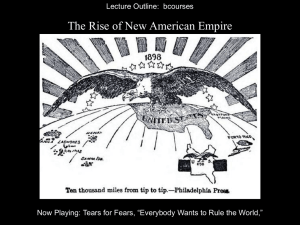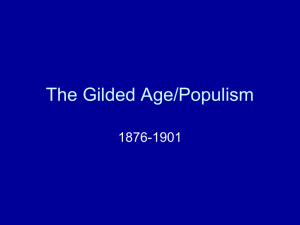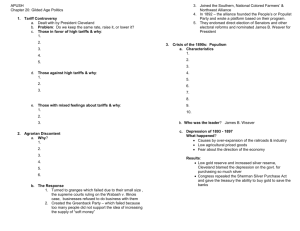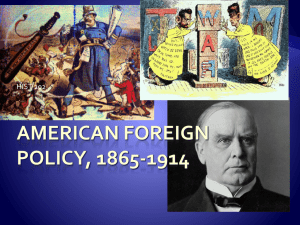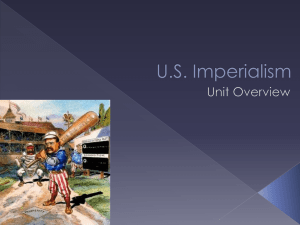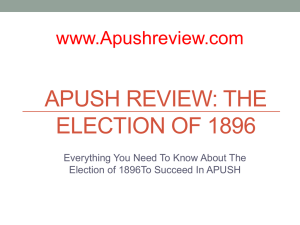Chapter 19
advertisement
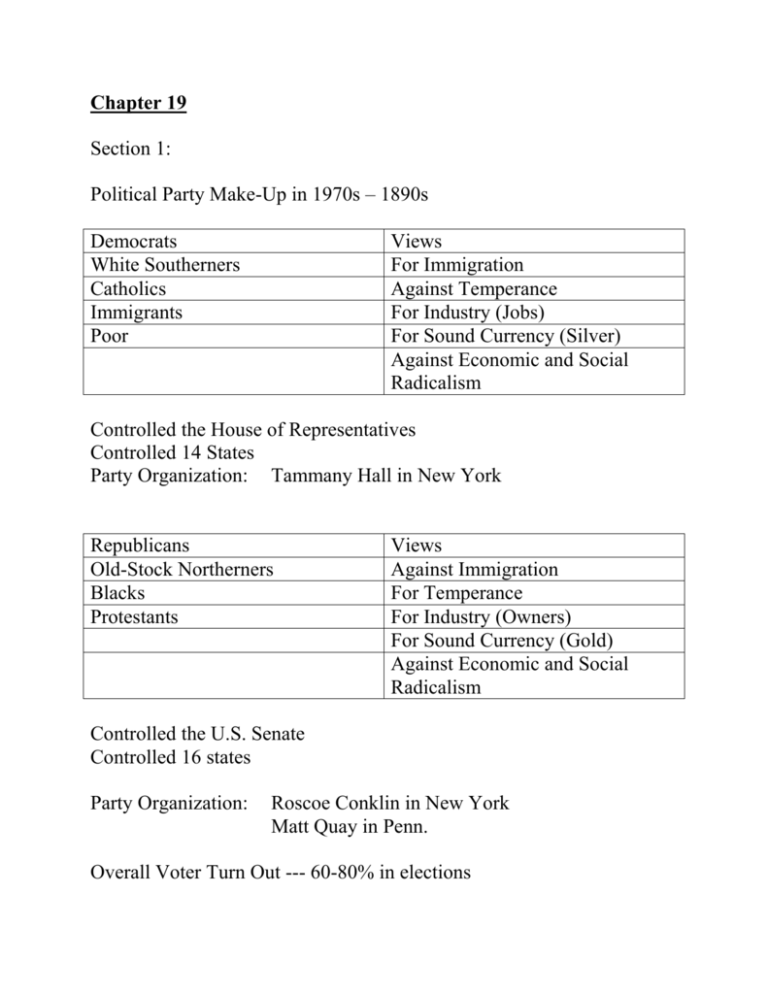
Chapter 19 Section 1: Political Party Make-Up in 1970s – 1890s Democrats White Southerners Catholics Immigrants Poor Views For Immigration Against Temperance For Industry (Jobs) For Sound Currency (Silver) Against Economic and Social Radicalism Controlled the House of Representatives Controlled 14 States Party Organization: Tammany Hall in New York Republicans Old-Stock Northerners Blacks Protestants Views Against Immigration For Temperance For Industry (Owners) For Sound Currency (Gold) Against Economic and Social Radicalism Controlled the U.S. Senate Controlled 16 states Party Organization: Roscoe Conklin in New York Matt Quay in Penn. Overall Voter Turn Out --- 60-80% in elections National Government Washington was responsible for 1) mail 2) national military 3) foreign policy 4) tariffs and taxes Presidents and patronage Presidents appointed over 100,000 people in office (there was no civil service) most based on party favors and most in the Post Office President Hayes (Rep) established the idea of Civil Service during his time to break up party power This idea led to a split in the Republican Party Stalwarts Roscoe Conklin – Traditional party politics Half-Breeds James Blaine of Maine – Reform Elections: 1880: James Garfield – Ohio – (Half-Breed) President Chester Arthur – Stalwart Vice President Won both House and Senate Garfield worked to make Civil Service real July 2, 1881 – Garfield shot and killed by office seeker Arthur now supports 1883 Pendleton Civil Service Act passed Written Exam Return of the Democrats Election of 1884 James Blaine (Half-Breed) Republican Candidate Mugwamps split to support Democrats Grover Cleveland – Democrat of New York Won Election Election of 1888 Grover Cleveland (Dem) Benjamin Harrison (Rep) Election of 1892 Grover Cleveland (Dem) 277 EV Benjamin Harrison (Rep) 145 EV James Weaver (People’s Party) - 166 EV and 100,000 more popular vote 233 EV – Won Election - Opposed protection tariffs 380,000 more popular votes Supported protection tariffs Economic Reform Democrats won both House and Senate Tariffs, Trusts, Railroads Trusts: Washington came out against Trusts July 1890 Sherman Anti-Trust Act Tariffs: McKinley Act (Rep) Oct 1890 High tariff on goods Railroads: Interstate Commerce Act – 1887 Banned discrimination in rates of long or short hauls Publish rates Five Person Agency – Interstate Commerce Commission Section 2: American Farmers Grangers: Oliver Kelley – 1867 National Grange of the Patrons of Husbandry Bring farmers together Initiation, ritual, code of secrecy 1875 – 800,000 members Against monopolies 1872 – Montgomery Ward & Co started 1880 – 100,000 members Alliances: 1880 – 4 million members Members – men, women, blacks (like the Knights of Labor) Had to be a farmer In 1892 – Founded the People’s Party Won a number of local, state and Congressional seats People’s Party on Populism Platform shorter hours for workers (D) restrictions on immigrations denounced use of detectives as strike breakers free silver to support money supply (D) abolition of national banks direct election of Senators (17th Amendment) government ownership of Railroads, telephones, telegraphs graduated income tax (16th Amendment) inflation of money (print more) wanted a Farm Bank – crops and money Chapter 19: Section 3 The Crisis of the 1890s The Panic of 1893 * Philadelphia and Reading Railroad declared bankruptcy (because of not being able to make loan payments) * Other companies started to fail and soon a wave of bank failures began * Farmers were hurt because of a depression in Europe * Within six months, 8000 businesses, 156 railroads, and 400 banks failed * 20% labor force lost their jobs * Lasted from 1895-1901 * In 1894 – A Populist named Jacob Coxey wanted massive public works program created and inflation of currency. When Congress did not move – he and about 500 others marched on Washington – called “Coxey’s Army” * Many strikes took place during this time (Homestead and Pullman) The Silver Question: In the 19c – currency was worthless unless it was backed up by something concrete The US recognized two metals – gold and silver for the dollar For purpose of creating money the government had to have gold or silver on hand for money at the rate of 16:1. Sixteen ounces of silver equaled one ounce of gold In 1873 – Congress Passed a law to discontinuing sliver coinage. It was called the “Crime of ’73.” Two groups wanted to undo this act – 1) silver mine owners and 2) discontented farmers President Cleveland felt that the Sherman Silver Purchase Act of 1893 (the government bought silver but did not make coins). Hurt the government. “Free Silver” became a symbol as the people’s money. And became a big subject between the two major parties. A Cross of Gold * The Populist Party needed a way to pull people into their party, other than farmers, and the silver issue was great for them. * The Republicans ran William McKinley of Ohio – and opposed the free coinage of silver * The Democrats ran William Jennings Bryan of Nebraska (36 years old – youngest in history). The Democrats called for tariff reduction, income tax, stricter control of trusts, free silver. * William Jennings Bryan made a speech at the Convention supporting free silver called the “Cross of Gold” speech. “You shall not press down upon the brow of labor this crown of thorns; you shall not crucify mankind upon a cross of gold!” * The Populist Party could name their own candidate or back another. They backed the Democratic Candidate Bryan. The Conservative Victory Business backed the Republican Party with 7 million dollars and the Democrats $300,000. Bryan was the first to go across the country to campaign. He told people why he was running instead of what he stood for. He lost. And soon after the Populist Party began to dissolve. McKinley and Recovery Supported high tariffs on goods Passed the Gold Standard Act of 1900 – made gold the standard for money Prosperity began to improve in 1898 A new issue was rising in America – the United States presence in world affairs and the possibility of America becoming an imperialist nation Ch 20 –Imperial Republic American had been expanding since its beginning. Pushing those in their way. Many believed it was the nation’s “Manifest Destiny” to expand The New Manifest Destiny of the 1890s included acquiring possessions outside the U.S. 1) New Manifest Destiny a. With the Depression of 1893 – business looked for new markets. Foreign b. Foreign Trade was important i. 1870 392 million ii. 1890 857 million iii. 1900 1.4 billion 2) Leaders of the time felt we needed to expand a. Sen. Henry Cabot Lodge and others expanded Charles Darwin Social Theory i. “Nations like biological species struggled constantly and only the fittest could survive.” b. John Fiske in 1885 wrote that English speaking people (and America the most) would control every land not already with an established civilization c. The best of the leaders was Captain Alfred Thayer Mahan. United States Navy – not a great naval captain (had the ability to ram hi own ships). He layed out a plan for America in his book The Influence of Sea Power upon History (1890). i. Countries with sea power were great nations in history 1. Egypt 2. Rome 3. Spain 4. England ii. In order to have a great sea power you must have: 1. A productive domestic economy 2. foreign commerce 3. a strong merchant marine 4. a navy to defend trade routes 5. colonies for raw goods, etc. and naval bases iii. Mahan felt that the US should 1. Construct a canal across the Isthmus of Central America 2. acquire defensive bases on both sides of the canal 3. take possession of Hawaii and other Pacific islands d. By 1900 the US Navy was the 3rd largest in the World i. England ii. Spain iii. US 3) Hemispheric Hegemony a. James Blaine (Sect. of St) organized in Oct 1889 the PanAmerican Congress (the idea was to create an organization to have all of the Americas work together – in reality it was a way to look for a place to sell our goods) i. Soon the Pan-American Union was created to serve as a clearinghouse of information for its members b. In 1895 – President Cleveland supported Venezuela in a boarder dispute with Great Britain. Using the Monroe Doctrine – the US forced Great Britain to arbitration. 4) Hawaii – a. American businessmen had been in Hawaii for many years on Sugar plantation. Instead of using local labor – Asian were brought in. b. In 1887, the US had a treaty to open a naval base at Pearl Harbor c. Natives did not like the way we had treated them. In 1891 they brought to power Queen Liliuokalani, who challenged the US control. d. In 1893, American Planters staged a revolt with the help of the US Navy. e. President Cleveland did not annex Hawaii because he felt the natives did not want it. f. President Harrison signed annexation in Feb. 1893 – however it was not acted upon. President Cleveland did not annex Hawaii because he felt the natives did not want it. g. In 1898 – Republicans returned to power in the Senate and took Hawaii. 5) Samoan Islands – had served American ships. In 1889, the US and Germany divided the islands. The US kept Pago Pago as a base. War with Spain 1) In 1895 – the Cubans rose up again a. Spanish Gen Weyler (the butcher) killed thousands of Cubans to put down the revolt. 2) Yellow Journalism – specialized newspapers in lurid and sensational news, when such news did not exist, editors were not above creating it. a. The conflict in Cuba came at a good time for newspapers. i. Joseph Pulitzer of the New York World ii. William Randolph Hearst of the New York Journal iii. “You furnish the pictures, and I’ll furnish the war.” iv. HAND OUT 3) McKinley becomes president in 1897 and took a strong issue with Spain over Cuba. Two campaign promises – protect American business and Free the Cuban people. a. No settlement was possible because of: i. February 9, 1898 – de Lome Letter. A Spanish diplomat sent a letter back to Spain that McKinley was a weak leader. Teddy Roosevelt said that McKinley had the backbone of a chocolate éclair. ii. February 15, 1898 - USS Maine blew up in Havana harbor. 260 American sailors killed after mysterious explosion. “Remember the Maine” became a battle cry. iii. February 25, 1898 – Teddy Roosevelt orders Admiral Dewey to sail to the Philippines. Be ready for war. 4) SPANISH- AMERICAN WAR a. April 11, 1898 – President McKinley asks Congress to declare war on Spain. April 25, 1898 – war is declared. b. May 1, 1898 – Dewey sinks the Spanish fleet at Manila Bay c. June 1898 – the US invades Cuba i. Roosevelt and his Rough Riders trained in San Antonio. ii. Attack San Juan Hill iii. America destroys Spanish Fleet in Cuba July, 3, 1898. d. August 12, 1898 – war over i. 385 – 460 American battle deaths ii. 5,200 killed because of disease and poisoned meat e. Back home – white and black soldiers had racial problems f. Treaty of Paris, December 1898 i. Spain recognizes the independence of Cuba ii. Gave Puerto Rico, Guam, Philippines to America iii. Teller Amendment – pledged that the US would guarantee self-rule for Cuba iv. Platt Amendment – restricted Cuban foreign policy and gave US land for coaling or naval station (still today) g. Philippine War – 1898-1902 i. Philippines wanted independence ii. On July 4, 1946 – finally gave islands their independence 5) Election of 1900 a. William McKinley runs for re-election with Teddy Roosevelt as his Vice-President Empire 1) China and “Open Door” Policy a. England, Germany, Russia, France, Japan, and Italy 2) Modern Military System a. Regular army to 100,000 b. National Guard established – no more volunteer militia for wars c. Army Staff College (later Command and General Staff School)
